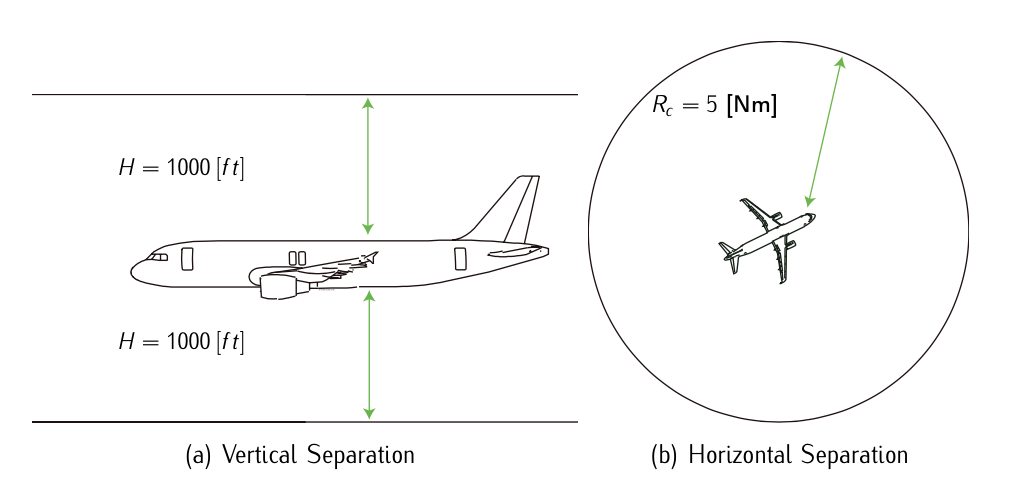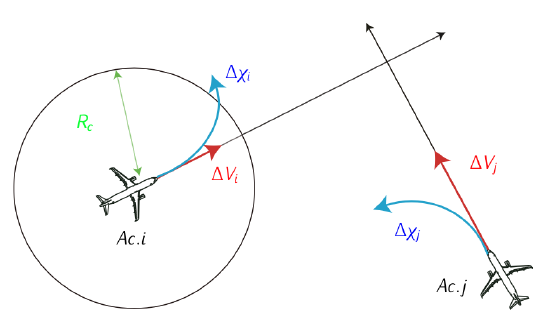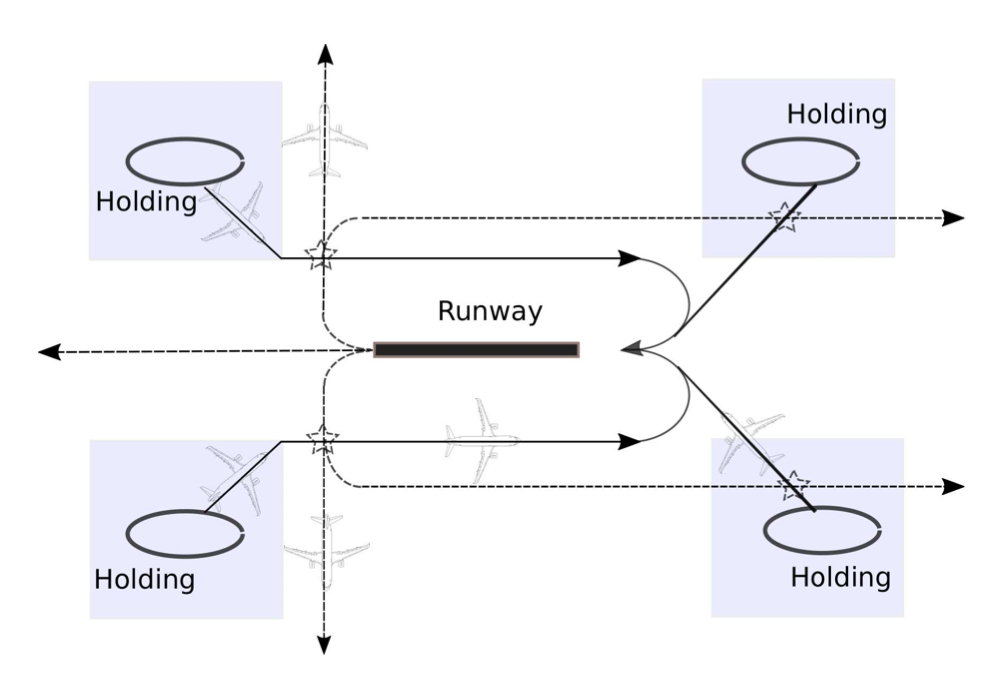10.5.2: Air Traffic Control
- Page ID
- 78384
Air Traffic Control (ATC) Service is probably the most well known service within the ATS services. It is provided for the purpose of preventing collisions (between aircraft, and between aircraft and obstacles); and expediting and maintaining an orderly flow of air traffic.

Figure 10.13: A typical minimum required separation for the en-route phase.
Before analysing the rol of air traffic controllers, it should be pointed out that aircraft have a safety volumen that should not be violated. A loss of separation minima), also referred to as mid-air conflict, can be defined as any situation in which a pair of aircraft are situated within a horizontal and vertical separation, \(D\) and \(H\), equal or lower than the minimum established by the regulators, \(D_{\min}\) and \(H_{\min}\), respectively. Figure 10.13 illustrates it for the typical values for en-route phase. When this cylinder is violated, a Mid-Air Conflict (MAC) occurs.

Figure 10.14: Vertical advisories through climb/descend maneuver.

Figure 10.15: Horizontal advisories through a turn maneuver (also referred to as vectoring) or a speed advisory.
Air traffic controllers (aided with safety alarms, human support tools, and other layers that apply such as the TCAS) are in charge of identifying potential Mid-air-Conflicts and advising aircraft different manoeuvres to avoid the conflict. Figure 10.14 and Figure 10.15 sketch vertical and horizontal advisories, respectively. If two aircraft are already in conflict, different back-up layers will get activated, e.g., TCAS, to avoid a potential collision.
Types of ATC
There are different types of ATC services, associated to different phases of the flight. These are: area control service, approach control service, aerodrome control service. Each of them acts on different volumes of airspace as introduced in Section 10.3.2 and sketched in Figure 10.10. These three types of ATC services give rise to three types of control (also sketched in Figure 10.10), namely:
- Aerodrome control (also referred to as Tower control) and labeled TWR control.
- Approximation control (also referred to as TMA control) and labeled APP control.
- Route control, labeled ACC control.
Aerodrome control: The volume of airspace in which aircraft separations are responsibility of the aerodrome control function is the so called Air Traffic Zone (ATZ), and includes the manoeuvres area and the aerodrome circuit. The aerodrome control is executed from the top of the control tower (in order to have complete visibility of the airfield). In a control tower, we typically find three types of controllers:
- Aerodrome controller, who assigns runways.
- Taxiway controller (surface controller), who manages surface movements.
- Authorisation controller, who authorises take-off.

Figure 10.16: Multidirectional flow of incoming and outgoing aircraft. Star indicate points of conflicting flows. Blue areas illustrate areas of sequencing.
Approximation control: Besides the ATZ (Airspace under responsibility of the tower control), the controlled airspace through which aircraft transit from landing/take-off to en-route is refereed to as Control Zone (CTR) (Also Terminal Maneuvering Area (TMA) or simply Control Area (CTA)). Approximation control is executed either from dependences inside the tower control or from dependences within an ACC (no direct vision is needed in this case). Approximation controllers have to lead with: take-off traffic, i.e., diverging aircraft (diverging flow); and landing traffic, i.e., converging aircraft (converging flow). Moreover, they have to manage separation between take-off and arriving flows, following a four corner post strategy as illustrated in Figure 10.16.
Approximation controllers’ main task are threefold:
- Sequencing, which is the action that establishes the time-order to access the point in which the common track starts.
- Merging, which is the action that allows aircraft coming from different routes to access that point in the given sequence.
- Metering, is the action that provides the required separation.
En-Route control: the controlled airspace through which aircraft transit the en-route phase is refereed to as en-route airspace. En-route control is executed from dependences referred to as Area Control Centres (ACC). Typically there is 1 to 2 ACCs per FIR/UIR. Two types of en-route controllers can be found in ACCs: executive and planners.
Executive controllers are in charge of handling potential conflicts (identifying and eventually solving) within the assigned ATC sector. Planner controllers are in charge of transmitting aircraft from one adjacent sector to another. It should be noticed that this two roles also appear in approximation control.
En-route aircraft are typically established at a constant speed and flight level. Nevertheless, we might also encounter aircraft ascending/descending: this type of aircraft are referred to as evolution traffic.


